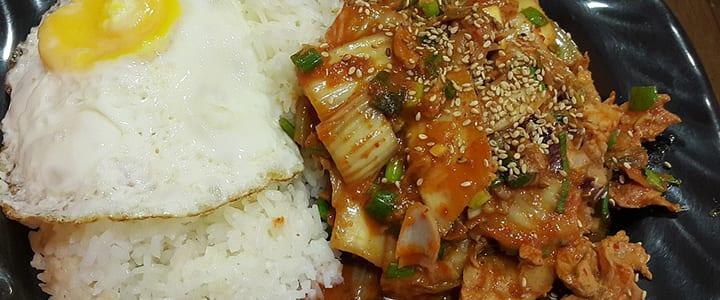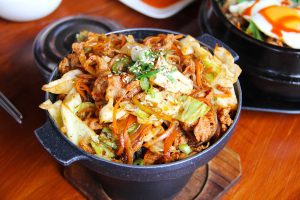Eating authentic Korean cuisine and dining with locals is one sure way to learn about Korean culture. But it’s also a great way to quickly master the Korean language. After all, it gives you the opportunity to practice ordering, incorporating the words and phrases you already know, and picking up new vocabulary along the way.
If you’re traveling around Korea and eating in Korean restaurants, you’ll soon realize there are several different dining experiences. Some are sit-down eateries where you will order through a waiter, and others are grab-and-go situations. Because each eatery differs slightly, we’ve provided some of the most useful Korean phrases you will want to know in each situation.
Check out our guide to eating in Korean eateries and brush up on the common Korean phrases and slang you will hear and use while dining out. Learn what to expect and how to order in Korean, and you’ll be closer to speaking fluently!
How to Order in Korean at an Eatery (식당)
In Korea, 식당 means “eatery.” These types of restaurants usually have Korean foods, along with other types of Asian foods like Korean-Chinese and Japanese. You will notice a typical 식당 has a menu on the wall, which includes the food and the prices.
When you enter a 식당, a waiter or waitress will welcome you by saying, “어서오세요” (welcome). Usually, you can sit wherever you want. Some 식당 have different seating arrangements. There may be tables and chairs, like a typical restaurant, or you may see a raised platform or low tables and flat pillows on the floor.
If you prefer to sit at a table with chairs, you can say, “테이블로 주세요” (table, please). Sitting on a flat pillow while you eat is incredibly uncomfortable, but if you’d like to try it, you can say, “방으로 주세요” (room, please). Remember to take off your shoes if you sit on the floor. If you sit at a table with chairs, you do not have to take off your shoes.
Once you sit down, look at the menu on the wall and let the waiter know what you’d like. The waiter will bring drinking water at no extra charge. If you want a different drink, you will have to let your server know.
While you eat, you can ask for additional side dishes or water. When you’re done eating, pay your check at the front of the restaurant. They typically don’t bring the check to the table in a 식당. In Korea, people do not leave tips. When you pay for your food, there’s no tax or tip added, so pay the exact amount you see on the menu. Nowadays, most places accept credit cards as well as cash.
Korean Phrases for Waiters and Diners
When learning Korean, the best way to expand your vocabulary is by putting it to use! So, let’s start by practicing how to order in Korean.
Here is a typical conversation you might have at a 식당. Since the conversation is taking place between two strangers, we will use the polite form.
Waiter: 어서오세요 (welcome) 몇분이세요 (how many are in your party?)
Customer: 세명이예요 (three, please) 테이블로 주세요 (please get us a table)
Once Seated:
Waiter: 뭐 드시겠어요 (What would you like?)
Customer: 김밥 하나랑 비빔밥 둘 주세요 or 김밥 일인분하고 비빔밥 이인분 주세요 (We will have one order of Kimbob and two orders of bibimbob, please.)
Waiter: 네 (yes)
Waiter: 여기 있습니다 (here you are) 맛있게 드세요 (enjoy your food)
Customer: 네 (yes) 감사합니다 (thank you)
While Eating:
Customer: 아저씨, 여기 김치랑 물 좀 더 주세요. (Mr. would you get us more kimchi and water, please?)
Waiter: 네 (yes)
At the Cashier:
Customer: 다해서 얼마에요 (how much is the total?)
Waiter: 만 삼천원입니다 (it’s 13,000 won)
Customer: 신용카드 되나요 (Do you accept credit cards?)
Waiter: 네 됩니다 (Yes, I do)
After Paying:
Customer: 맛있게 먹었습니다 or 잘 먹었습니다 (It was delicious)
Other Korean food phrases you may need to know:
- 기다리셔야합니다 (there is a wait)
- 무엇을 주문하시겠어요? (what would like to order?)
- 맛있어요 (it’s delicious)
- 배불러요 (I’m full)
- 따로 따로 계산할수 있나요? (can we pay separately?)
- 내가 낼께 (it’s on me) – informal, used between friends.
- 제가 낼께요 (it’s on me) – formal
Counting in Korean
In Korean, there are two sets of counting systems (Korean and Chinese), and the item you’re counting determines which system you use. Also, the form of the number and the particle that follows can change.
When you indicate the number of people in your party, use the Korean numbering system, 하나, 둘, 셋, 넷, 다섯, 여섯, 일곱, 여덟, 아홉, 열, (original form of Korean numbers, 1 to 10 ). When -명 (particle that means person) is added, the original forms of the numbers change to 한명 (one person), 두명 (two people), 세명 (three people), 네명 (four people), 다섯명 (five people), 여섯명 (six people), 일곱명 (seven people), 여덟명 (eight people), 아홉명 (nine people), 열명 (10 people).
After the number of people, just add 이예요 to say it politely: “한명이예요” (one person, please).
When it comes to money, use the Chinese numbering system (일, 이, 삼, 사, 오 육, 칠, 팔, 구, 십, 1 to 10).
- 일)천원 (1000 won) – 일 is omitted
- 이천원 (2000 won)
- 삼천원 (3000 won)
- 사천원 (4000 won)
- 오천원 (5000 won)
- 육천원 (6000 won)
- 칠천원 (7000 won)
- 팔천원 (8000 won)
- 구천원 (9000 won)
- 만원 (10,000 won)
- 만삼천원 (13,000 won)
- 오만원 (50,000 won)
- 육만칠천원 (67,000 won)
- 십만원 (100,000 won)
There are two different ways to indicate the number of orders. You can use the Chinese numbering system such as 일인분, 이인분 (one order, two orders). When the numbers are combined with 인분 (order), the numbers keep the original forms.
Informally, you can use the Korean numbering system (김밥 하나, 비빔밥 둘) and it stems from counting individual items. When the numbers are combined with 개 (particle that means piece), some numbers modify their original forms like 한개, 두개, 세개, 네개, 다섯개, 여섯개, 일곱개, 여덟개, 아홉개, 열개 (one piece, two pieces…10 pieces).
If it’s one or two orders, you can informally say 김밥 하나, 비빔밥 둘 주세요 (one Kim-bob and two bibimbobs, please). If it’s more than three, say 비빔밥 세개 주세요 (three bibimbos, please) instead of비빔밥 셋 주세요.
Also, In some situations, you can order food by the number of pieces of food. In that case, you can use this expression: 만두 열개 주세요 (I’d like 10 pieces of Mandu (Korean meat dumplings)).
How to Order in Korean at a Restaurant or Cafe (레스토랑, 까페)
In Korea, 레스토랑 and 까페 usually serve Western food. They bring you a menu before you order. They do not have floor seating like a 식당. Tables in a typical 레스토랑 are private. You might see curtains or walls between tables for more privacy. Many people just order drinks, and that’s OK. They may bring the check to your table, or you may have to pay at the cashier. The rest is similar to eating at a 식당. The following are a few common Korean phrases you may use or hear in a restaurant phases or cafe:
- 메뉴주세요 (Menu, please)
- 계산서주세요 (check, please)
- 금연석으로 주세요 (non-smoking seat, please)
How to Order in Korean at a Market or Street Vendor (시장, 포장마차)
When you go to a 시장 or stop by a 포장마차, you will see the food is ready to be served and has been kept warm. All you need to say is “one order, please” and you can start eating right away. Some establishments have a place to sit, but some may not. Markets and street vendors are generally pretty inexpensive.
You may see a menu displayed, but you may not. If you don’t see a menu, you can ask the vendor and learn the name of the food and the price. Also, the foods are generally ordered “to-go.” Familiarize yourself with some of these phrases when you want to order in Korean at a market or street vendor:
- 이거 뭐예요 (what is this?) – ask as you point to the food
- 떡뽁기이예요 (it is) 떡뽁기 – a typical Korean street food: spicy rice cake with fish cake and veggies
- 얼마에요? (how much is it?)
- 삼천원이예요 (it is 3000 won)
- 일인분주세요 (I’d like one order, please)
- 여기서 드실꺼예요? (Would you like to eat here)
- 네 = Yes, 아니요 (No)
- 싸 드릴까요? (is it to go?)
- 싸 주세요 (it is to go)
How to Order in Korean at Fast Food Restaurants
Fast food restaurants in Korea are very similar to fast food restaurants in other countries. You walk up to the cashier, order your food, and get your receipt with a number. When your number is called, the food is ready.
You should learn to order by item number: “일번 주세요” (I’ll have the number one). In this case, use the Chinese numbering system (일, 이, 삼, 사, 오 육, 칠, 팔, 구, 십, 1 to 10). After the number, just add 번 주세요.
Korean Food Vocabulary
Now that you’re familiar with some common Korean restaurant phrases, what exactly are you going to order? Below we’ve listed out some of the most common food phrases in Korean you’ll find on the menu:
- Kimchi (김치): Spicy cabbage side dish
- Soy sauce crab (간장게장): Crab marinated in soy sauce
- Tteokbokki (떡볶이): Rice cakes cooked with fish cakes in a chili paste
- Samgyetang (삼계탕): Soup with stuffed chicken in the broth
- Doenjang jjigae (된장찌개): Stew with doenjang paste, peppers, tofu, mushrooms, and anchovies
- Haemul Pajeon (해물파전): Korean pancakes with seafood
- Chimaek (치맥): Pairing of fried chicken and beer
- Bossam (보쌈): Steamed pork
- Bulgogi (불고기): Sweet meat dish
- Galbi (갈비): Grilled meat marinated in soy sauce, garlic, and sugar
And when it comes to ordering food with Korean phrases, you’ll want to know some common beverages on the menu:
- Pebsi (콜라): Pepsi
- Maekju (맥주): Beer
- Nokcha (녹차): Green tea
- Soju (소주): Korea’s national liquor
- Sikhye (식혜): Cold rice dessert-like drink
- Misutgaru (미숫가루): Protein shake made with nuts, beans, and grains
- Sigsu (식수): Water
- Baekseju (백세주): Yellow wine made from rice
Armed with these must-know Korean phrases, you should feel confident eating in Korean restaurants of all kinds. Next time you go out to eat Korean food, take advantage of the opportunity to practice your basic Korean phrases with language skills. You’re sure to learn more about the culture, try delicious cuisine, and make friends along the way!
Sign up For Korean Lessons
While immersing yourself in situations where you can speak Korean, like eating in Korean restaurants, is great for improving your language skills, nothing beats studying with a private tutor.
When you sign up for Korean lessons online or in-person, you have the opportunity to work one-on-one with a private instructor who will help you reach your Korean language goals. Whether you want to learn Korean so you can travel around Seoul or discover more about the culture, our lessons can help. Sign up to start your first Korean lesson with us today!

Post Author: Hannah V.
Hannah is a Korean instructor in Paradise Valley, AZ. A native Korean speaker, she earned her Master’s degree from the University of Texas in Austin. Learn more about Hannah here!
Maile Proctor


